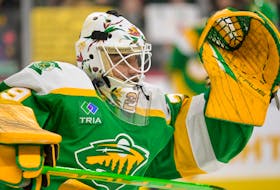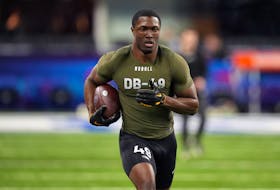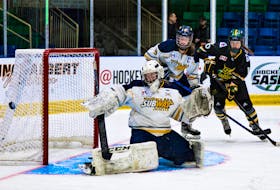As Jamal Murray’s dream of a playoff season begins to wind down, I find myself oddly thinking about Mike Smrek.
And about then and now.
You probably don’t know the name.
In 1988, the year now famous for Ben Johnson, I was sent to Los Angeles to do a feature story on Smrek.
He was one of the few Canadians in the NBA back then, living in this underwhelming hotel just across the street from the Fabulous Forum.
Smrek was 7-foot, white, friendly and slightly awkward. He was the backup for Kareem Abdul-Jabbar, who really didn’t need a backup on those phenomenal Lakers championship teams.
Smrek has two NBA rings to prove he was there.
When I went to interview Abdul-Jabbar about Smrek, he actually thought it was a prank of some kind.
You’re asking about who? Why? You’re serious?
That was Canadians in the NBA then.
In 21 playoffs games over eight seasons, Smrek, from Welland, scored 11 points.
Inside the bubble, Jamal Murray of Kitchener, a 90-minute drive from Welland, does that about every 11 minutes.
He has put on a show this NBA playoff like we’ve rarely seen before.
In Game 7 against Kawhi Leonard and the Los Angeles Clippers, he scored 40 points in a stunning one-sided Denver win.
Against Utah the round before, he scored 50, 42 and 50 in three consecutive games. Breathtaking numbers for any player.
But for a Canadian, considering the history, it’s more than that.
It’s Steve Nash-like and he won two MVP awards, which still defy possibility and probability.
The other day, a German won the Hart Trophy as the NHL’s most valuable player; a Swiss won the Norris Trophy as best defenceman; an American won the Vezina Trophy and if the Conn Smythe Trophy was voted on today, the competition would be between a Russian, a Kazakh, a Swede and a Finn.
Our game isn’t just ours anymore. Just as we’ve entered games that were never ours.
The contrast of Murray now to Smrek then is not just about basketball. It’s about this country.
It’s about the amazing depth of athletes we have, a national roster like never before. It’s about a Canada, strong and free and sporting, like no Canada before it.
The first significant tennis tournament I covered saw Bjorn Borg defeat John McEnroe in the 1979 Canadian Open final.
A few weeks after that, McEnroe went on to win his first major, the U.S. Open.
There were no Canadians in the main draw of the U.S. Open that year, but there were 63 Americans. In the last few days, while Murray has continued to star for Denver, Denis Shapovalov has moved to 10th in the world of men’s tennis, not that far ahead of Felix Auger-Aliassime and Milos Raonic.
As we continue to wait for the return of U.S. Open champion Bianca Andreescu, she remains ranked seventh in the world.
The top Canadian tennis player in 1979, when Borg won at York University, was Rejean Genois, who outside of Quebec is about as famous today as Smrek. The top American tennis player is John Isner, who is rated below three Canadians.
You can go sport to sport now and see the accomplishments of Canadians and the strength and depth seems to be growing by the day. And in places where we normally don’t exist.
On Sunday, Chase Claypool, a tall 22-year-old from Abbotsford, B.C., playing in his second game in the NFL for the Pittsburgh Steelers, scored on a 84-yard touchdown pass from Ben Roethlisberger. No Canadian has ever done that before.
The debut of Claypool comes in the same year in which Alfonso Davies, the youngster from Edmonton, and Toronto’s Kadeisha Buchanan win championships at the highest level of club soccer and as important players on their teams.
Both should already be in the Lou Marsh discussion for Canadian athlete of the year, along with Murray of basketball, along with Nathan MacKinnon of hockey, along with Shapovalov of tennis, along with Super Bowl champion Dr. Laurent Duvernay-Tardif, along with the perennial golf contender Brooke Henderson.
Once upon a time in Canadian sport, there was Ferguson Jenkins and just about no one else on the highest pedestal of sport that wasn’t hockey.
We probably take Jenkins for granted now, especially in a year in which Larry Walker was supposed to be inducted into the Baseball Hall of Fame.
But take a moment, if you can, and look up his career statistics. At a different time, in really a different game, Jenkins won 20 games seven different times, had eight seasons of 20 or more complete games, had 11 seasons of 240 or more innings pitched, five seasons of more than 300 innings.
He was on his own, putting up Murray kind of numbers from baseball in the ’60s and ’70s. And Murray’s not alone, not even in the NBA, where Shai Gilgeous-Alexander and others are next in line. And Jonathan David isn’t that far behind Davies. And Buchanan follows Christine Sinclair. And that’s without going into the exploits of Joey Votto, who is clearly nearing the end as a major-league player.
We expect McDavid and Sidney Crosby and MacKinnon to be the top players in hockey. We always have that. The rest is new and wondrous and fascinating and growing.
With all these golfers who can contend on almost any PGA week. Henderson, still a kid, among the best in the world. And Murray, with at least another game to go against LeBron James and the Los Angeles Lakers and we hope more. We want more.
And all this happening around this special week of Schitt’s Creek; we are far more than a country that just makes people laugh.
We can hit a lot of threes in a whole lot of sports — and that makes my heart beat just a little bit louder.
[email protected]
twitter.com/simmonssteve
Copyright Postmedia Network Inc., 2020








